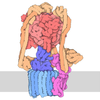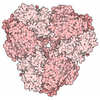+ Open data
Open data
- Basic information
Basic information
| Entry | Database: EMDB / ID: EMD-5757 | |||||||||
|---|---|---|---|---|---|---|---|---|---|---|
| Title | Structural mechanism of the dynein powerstroke | |||||||||
 Map data Map data | Reconstruction of axonemal dyneins in post-powerstroke state. In the erythro-9-[3-(2-hydroxynonyl)]-adenine inhibited sea urchin sperm flagella, the outer arm dyenins show post-powerstroke conformations. | |||||||||
 Sample Sample |
| |||||||||
 Keywords Keywords | dynein movement / flagellar motility / axoneme | |||||||||
| Function / homology |  Function and homology information Function and homology informationkaryogamy / astral microtubule / establishment of mitotic spindle localization / nuclear migration along microtubule / spindle pole body / minus-end-directed microtubule motor activity / dynein light intermediate chain binding / cytoplasmic dynein complex / dynein intermediate chain binding / nuclear migration ...karyogamy / astral microtubule / establishment of mitotic spindle localization / nuclear migration along microtubule / spindle pole body / minus-end-directed microtubule motor activity / dynein light intermediate chain binding / cytoplasmic dynein complex / dynein intermediate chain binding / nuclear migration / establishment of mitotic spindle orientation / mitotic sister chromatid segregation / cytoplasmic microtubule / cytoplasmic microtubule organization / Neutrophil degranulation / mitotic spindle organization / cell cortex / ATP hydrolysis activity / ATP binding / cytoplasm Similarity search - Function | |||||||||
| Biological species |  | |||||||||
| Method | subtomogram averaging / cryo EM / Resolution: 34.0 Å | |||||||||
 Authors Authors | Lin J / Okada K / Raytchev M / Smith MC / Nicastro D | |||||||||
 Citation Citation |  Journal: Nat Cell Biol / Year: 2014 Journal: Nat Cell Biol / Year: 2014Title: Structural mechanism of the dynein power stroke. Authors: Jianfeng Lin / Kyoko Okada / Milen Raytchev / Maria C Smith / Daniela Nicastro /  Abstract: Dyneins are large microtubule motor proteins required for mitosis, intracellular transport and ciliary and flagellar motility. They generate force through a power-stroke mechanism, which is an ATP- ...Dyneins are large microtubule motor proteins required for mitosis, intracellular transport and ciliary and flagellar motility. They generate force through a power-stroke mechanism, which is an ATP-consuming cycle of pre- and post-power-stroke conformational changes that cause relative motion between different dynein domains. However, key structural details of dynein's force generation remain elusive. Here, using cryo-electron tomography of intact, active (that is, beating), rapidly frozen sea urchin sperm flagella, we determined the in situ three-dimensional structures of all domains of both pre- and post-power-stroke dynein, including the previously unresolved linker and stalk of pre-power-stroke dynein. Our results reveal that the rotation of the head relative to the linker is the key action in dynein movement, and that there are at least two distinct pre-power-stroke conformations: pre-I (microtubule-detached) and pre-II (microtubule-bound). We provide three-dimensional reconstructions of native dyneins in three conformational states, in situ, allowing us to propose a molecular model of the structural cycle underlying dynein movement. | |||||||||
| History |
|
- Structure visualization
Structure visualization
| Movie |
 Movie viewer Movie viewer |
|---|---|
| Structure viewer | EM map:  SurfView SurfView Molmil Molmil Jmol/JSmol Jmol/JSmol |
| Supplemental images |
- Downloads & links
Downloads & links
-EMDB archive
| Map data |  emd_5757.map.gz emd_5757.map.gz | 294.3 KB |  EMDB map data format EMDB map data format | |
|---|---|---|---|---|
| Header (meta data) |  emd-5757-v30.xml emd-5757-v30.xml emd-5757.xml emd-5757.xml | 10.1 KB 10.1 KB | Display Display |  EMDB header EMDB header |
| Images |  400_5757.gif 400_5757.gif 80_5757.gif 80_5757.gif | 58.3 KB 4.5 KB | ||
| Archive directory |  http://ftp.pdbj.org/pub/emdb/structures/EMD-5757 http://ftp.pdbj.org/pub/emdb/structures/EMD-5757 ftp://ftp.pdbj.org/pub/emdb/structures/EMD-5757 ftp://ftp.pdbj.org/pub/emdb/structures/EMD-5757 | HTTPS FTP |
-Validation report
| Summary document |  emd_5757_validation.pdf.gz emd_5757_validation.pdf.gz | 309.6 KB | Display |  EMDB validaton report EMDB validaton report |
|---|---|---|---|---|
| Full document |  emd_5757_full_validation.pdf.gz emd_5757_full_validation.pdf.gz | 309.2 KB | Display | |
| Data in XML |  emd_5757_validation.xml.gz emd_5757_validation.xml.gz | 4.5 KB | Display | |
| Arichive directory |  https://ftp.pdbj.org/pub/emdb/validation_reports/EMD-5757 https://ftp.pdbj.org/pub/emdb/validation_reports/EMD-5757 ftp://ftp.pdbj.org/pub/emdb/validation_reports/EMD-5757 ftp://ftp.pdbj.org/pub/emdb/validation_reports/EMD-5757 | HTTPS FTP |
-Related structure data
| Related structure data |  3j67MC  5758C  3j68C M: atomic model generated by this map C: citing same article ( |
|---|---|
| Similar structure data |
- Links
Links
| EMDB pages |  EMDB (EBI/PDBe) / EMDB (EBI/PDBe) /  EMDataResource EMDataResource |
|---|---|
| Related items in Molecule of the Month |
- Map
Map
| File |  Download / File: emd_5757.map.gz / Format: CCP4 / Size: 344.7 KB / Type: IMAGE STORED AS FLOATING POINT NUMBER (4 BYTES) Download / File: emd_5757.map.gz / Format: CCP4 / Size: 344.7 KB / Type: IMAGE STORED AS FLOATING POINT NUMBER (4 BYTES) | ||||||||||||||||||||||||||||||||||||||||||||||||||||||||||||||||||||
|---|---|---|---|---|---|---|---|---|---|---|---|---|---|---|---|---|---|---|---|---|---|---|---|---|---|---|---|---|---|---|---|---|---|---|---|---|---|---|---|---|---|---|---|---|---|---|---|---|---|---|---|---|---|---|---|---|---|---|---|---|---|---|---|---|---|---|---|---|---|
| Annotation | Reconstruction of axonemal dyneins in post-powerstroke state. In the erythro-9-[3-(2-hydroxynonyl)]-adenine inhibited sea urchin sperm flagella, the outer arm dyenins show post-powerstroke conformations. | ||||||||||||||||||||||||||||||||||||||||||||||||||||||||||||||||||||
| Projections & slices | Image control
Images are generated by Spider. generated in cubic-lattice coordinate | ||||||||||||||||||||||||||||||||||||||||||||||||||||||||||||||||||||
| Voxel size | X=Y=Z: 9.856 Å | ||||||||||||||||||||||||||||||||||||||||||||||||||||||||||||||||||||
| Density |
| ||||||||||||||||||||||||||||||||||||||||||||||||||||||||||||||||||||
| Symmetry | Space group: 1 | ||||||||||||||||||||||||||||||||||||||||||||||||||||||||||||||||||||
| Details | EMDB XML:
CCP4 map header:
| ||||||||||||||||||||||||||||||||||||||||||||||||||||||||||||||||||||
-Supplemental data
- Sample components
Sample components
-Entire : Cryo-electron tomography and subtomographic average (1100 axonema...
| Entire | Name: Cryo-electron tomography and subtomographic average (1100 axonemal repeats) of inactive Strongylocentrotus purpuratus (sea urchin) sperm flagella. |
|---|---|
| Components |
|
-Supramolecule #1000: Cryo-electron tomography and subtomographic average (1100 axonema...
| Supramolecule | Name: Cryo-electron tomography and subtomographic average (1100 axonemal repeats) of inactive Strongylocentrotus purpuratus (sea urchin) sperm flagella. type: sample / ID: 1000 Details: The flagellar motility was completely inhibited by erythro-9-[3-(2-hydroxynonyl)]-adenine before the cryo sample preparation. Number unique components: 1 |
|---|
-Supramolecule #1: dynein
| Supramolecule | Name: dynein / type: organelle_or_cellular_component / ID: 1 Details: Erythro-9-[3-(2-hydroxynonyl)]-adenine completely inhibited sperm flagellar motility, and kept the axonemal dyneins in post-powerstroke states. Recombinant expression: No / Database: NCBI |
|---|---|
| Source (natural) | Organism:  |
-Experimental details
-Structure determination
| Method | cryo EM |
|---|---|
 Processing Processing | subtomogram averaging |
| Aggregation state | tissue |
- Sample preparation
Sample preparation
| Buffer | pH: 8 Details: 360 mM NaCl, 50 mM MgCl2, 10 mM CaCl2, 10 mM KCl, 30 mM HEPES, pH 8.0, 2 mM erythro-9-[3-(2-hydroxynonyl)]-adenine |
|---|---|
| Grid | Details: Quantifoil holey carbon grids Cu 200 mesh R2/2 |
| Vitrification | Cryogen name: ETHANE / Chamber temperature: 100 K / Instrument: HOMEMADE PLUNGER / Method: Blot for 1.5-2.5 seconds before plunging. |
- Electron microscopy
Electron microscopy
| Microscope | FEI TECNAI F30 |
|---|---|
| Temperature | Average: 80 K |
| Specialist optics | Energy filter - Name: GATAN postcolumn filter GIF / Energy filter - Lower energy threshold: 0.0 eV / Energy filter - Upper energy threshold: 20.0 eV |
| Date | Apr 28, 2012 |
| Image recording | Category: CCD / Film or detector model: GENERIC GATAN (2k x 2k) / Average electron dose: 100 e/Å2 |
| Electron beam | Acceleration voltage: 300 kV / Electron source:  FIELD EMISSION GUN FIELD EMISSION GUN |
| Electron optics | Illumination mode: FLOOD BEAM / Imaging mode: BRIGHT FIELD / Nominal defocus max: 8.0 µm / Nominal defocus min: 6.0 µm / Nominal magnification: 13500 |
| Sample stage | Specimen holder: Liquid nitrogen cooled / Specimen holder model: GATAN LIQUID NITROGEN / Tilt series - Axis1 - Min angle: -65 ° / Tilt series - Axis1 - Max angle: 65 ° |
| Experimental equipment |  Model: Tecnai F30 / Image courtesy: FEI Company |
- Image processing
Image processing
| Final reconstruction | Algorithm: OTHER / Resolution.type: BY AUTHOR / Resolution: 34.0 Å / Resolution method: FSC 0.5 CUT-OFF / Software - Name: IMOD, PEET Details: Final maps were calculated by averaging 1100 particles from 9 tomograms. 1100 axonemal repeats (96 nm long) from 9 tomograms (reconstructed using fiducial alignment and weighted ...Details: Final maps were calculated by averaging 1100 particles from 9 tomograms. 1100 axonemal repeats (96 nm long) from 9 tomograms (reconstructed using fiducial alignment and weighted backprojection, IMOD software, Kremer et al. 1996) were aligned and averaged using the PEET software (bio3d.colorado.edu, Nicastro et al. 2006). Number subtomograms used: 1100 |
|---|
 Movie
Movie Controller
Controller




















 Z (Sec.)
Z (Sec.) Y (Row.)
Y (Row.) X (Col.)
X (Col.)





















